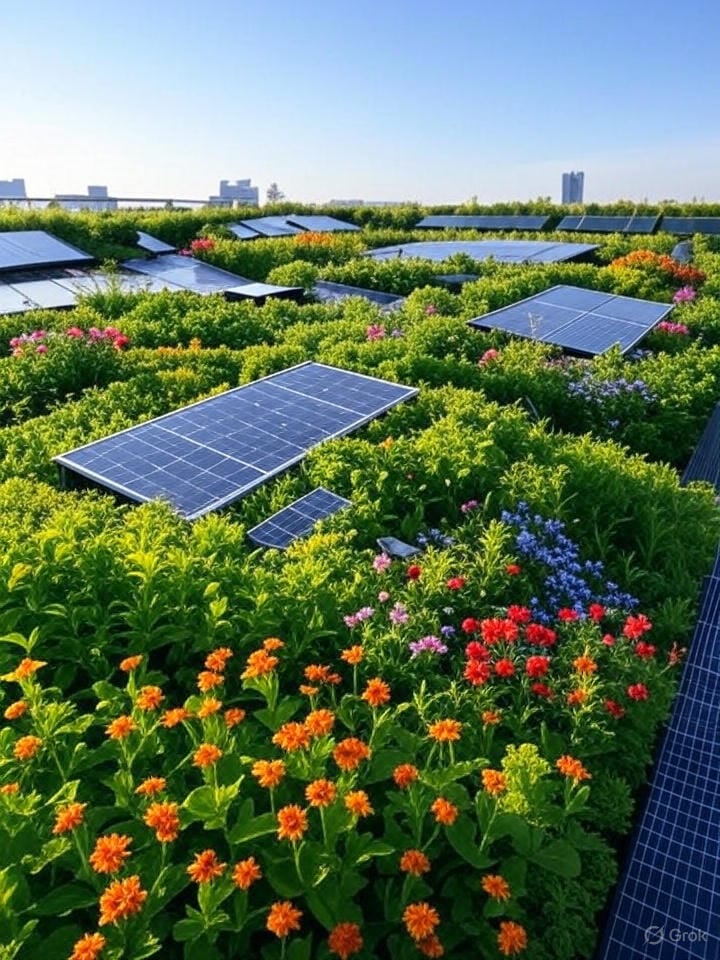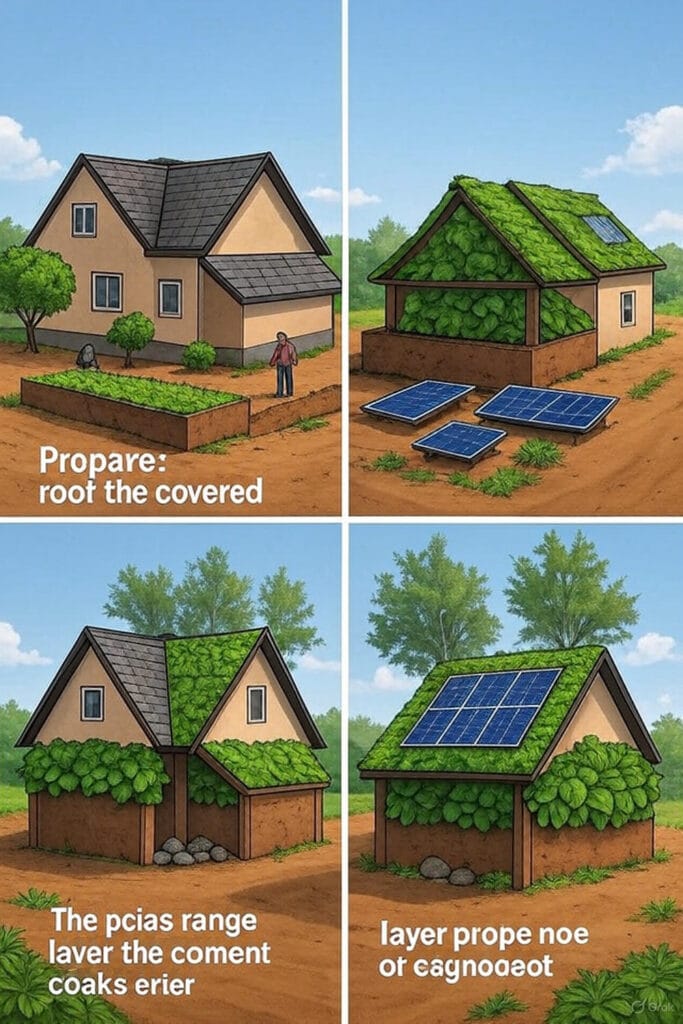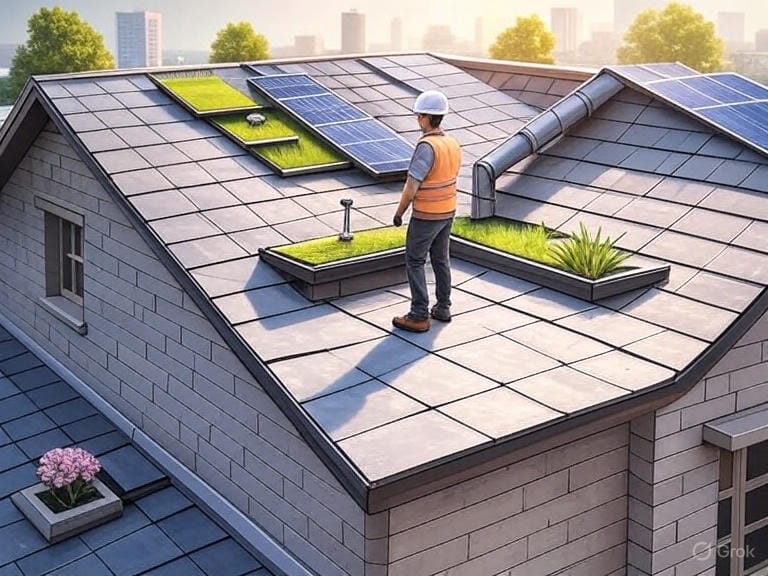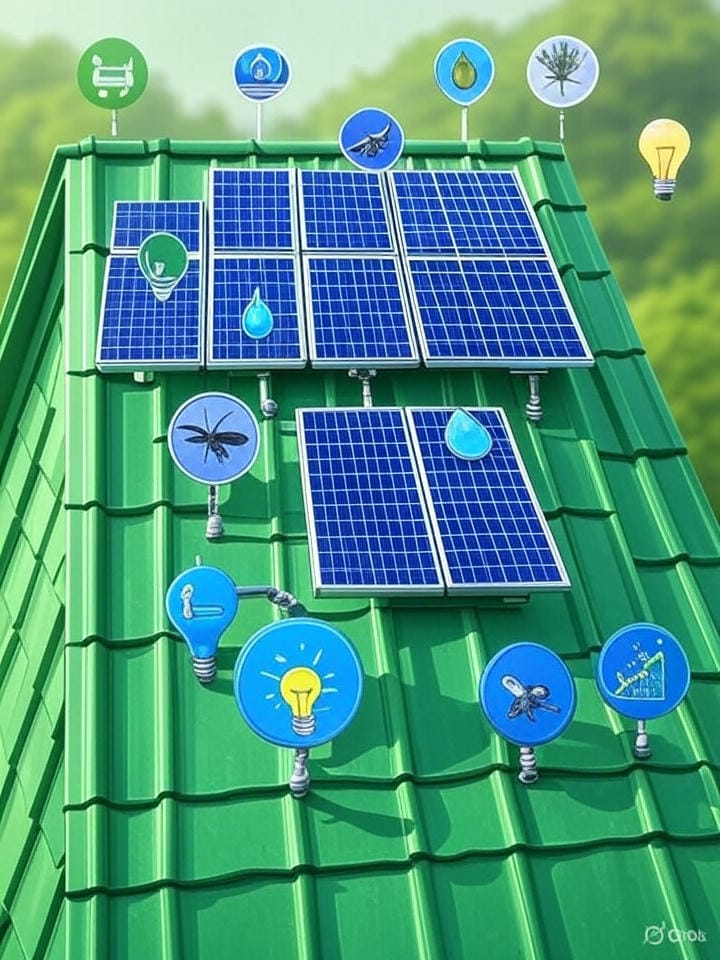
Table of Contents
ToggleWhat is solar integration on green roofs?
Solar panels on a green roof are an innovative approach that combines two of the most powerful eco-friendly technologies – green roofs and solar panels. We know that green roofs provide insulation, rainwater management, and urban cooling through their natural vegetation. Combination solar panels and green roof will create a highly efficient and sustainable system that generates clean energy and supports the local environment.
The concept of green roofing solar integration is gaining popularity in modern cities where the demand for space-efficient and eco-conscious solutions is at an all-time high. Since urban rooftops are often underutilized, property owners can maximize energy efficiency and environmental benefits by turning them into a dual-purpose space.
This integration also creates a unique synergy: the plants on the green roof help to keep the building cooler, which improves the performance and lifespan of solar panels. In return, solar panels provide shading to vegetation that protects them from extreme sunlight. This mutual support makes solar installation on green roofs a complete eco-friendly energy strategy.
This concept allows our homes, offices and even large commercial spaces to reduce carbon emissions and cut down on energy costs with contributing more on urban biodiversity. Before you know the sustainable solar green roof benefits, you must understand the integration through this article.

Plan for sustainable solar green roof
A successful sustainable solar green roof project doesn’t start with installation, it starts with careful planning. The planning stage is important because it sets the foundation for safety, efficiency, and long-term performance. And here’s how to make a plan :-
Structural Assessment
Every building has a weight limit. A green roof adds soil, plants, and water + solar panels and mounting systems. All these mechanisms create a heavy load on the roof and that’s why it’s necessary to confirm whether your rooftop can carry this load. You can hire a professional structural engineer for weight calculations and recommendations. The type of green roof also matters.
Climate and Location Study
Your local weather conditions will shape the design of your project. For example, in hot regions choosing drought-resistant plants is essential, but in colder areas you need to grow plants that can handle frost. Similarly, the path of the sun will decide how solar panels should be angled on our rooftop.
Plant and Growing Medium Selection
Not all plants are suitable for rooftops. Green roofs work best with low maintenance & lightweight vegetation like sedums, succulents or hardy grasses. The medium should be placed in a way to obtain light, and it should also be capable of retaining enough moisture. This step ensures that your green roof is practical and long-lasting.
Solar Technology and Mounting Choices
There are different types of solar panels and Mounting systems available in market. Some mounts are ballasted (held in place with weight) and don’t require any drilling on the roof, which helps to protect waterproofing layers. The right system prevents leaks and extends the durability of the structure.
Water and Drainage Planning
We know that green roofs need water, but too much water can also damage them. This is why drainage layers, irrigation systems and water retention mats should be included in the design. If you want to avoid future pooling or plant death issues, you have to plan how water will move across the roof.
Access and Maintenance Routes
Think about the long term. Create clear walkways or space between solar arrays so that both the panels and plants can be serviced easily. Proper access for routine cleaning and maintenance can help you minimize complications.
Budgeting and Incentives
Once your plan is made, align it with your Budget. Check local policies for tax breaks, rebates or sustainability grants. In many regions those owners who combine solar with green roofs can qualify for financial incentives which can significantly reduce upfront costs.

How solar panels on green roof are installed?
Converting a plain rooftop into a living & power-generating surface may sound complicated. However, if we break down the process into clear steps then it becomes a manageable. Here’s a practical step-by-step guide to achieving success in solar integration on green roofs.
Step 1: Initial Inspection and Feasibility Study
Every project starts with a rooftop inspection. Professional engineers will check the root’s age, waterproofing and structural strength. This study would confirm whether the roof can safely hold soil, vegetation, and solar panels together or not. It also identifies that the roof needs any reinforcement or repair before installation.
Step 2: Designing the Green Roof Base Layers
A functional green roof has multiple layers: waterproofing, root barrier, drainage, filter fabric, growing medium and plants. Each layer must be planned carefully to protect the building and support vegetation. If you don’t want leaks or poor plant growth then don’t skip design stage.
Step 3: Choosing the Right Solar Mounting System
Solar panels can be installed by using ballasted systems (weighted down) or non-penetrating racks. Ballasted or hybrid mounts are ideal for most green roofs because they don’t damage waterproof membranes. The position of the solar panels should be angled to capture maximum sunlight without shading large areas of plants.
Step 4: Installing Drainage and Irrigation Systems
Green roofs must manage both heavy rain and dry spells. That’s why drainage mats and irrigation lines are added before placing plants. These systems keep water moving properly and ensure vegetation’s health without flooding the structure. Panels must be installed in a way that doesn’t block water flow.
Step 5: Planting and Vegetation Setup
Usually we select plants like sedums or native grasses which require low maintenance and they can survive with little care. To ensure panels and vegetation complement each other, planting is done after the solar racks are in place. The greenery helps to regulate roof temperature and panels provide partial shade from extreme sunlight.
Step 6: Solar Panel Installation and Electrical Connection
The solar array is mounted after the green roof is ready. Electricians connect the system to inverters and the building’s power supply. Enough spaces are left around the panels for Air circulation and future maintenance access.
Step 7: Final Testing and System Integration
Both systems are tested together once they are installed. Engineers check energy output, waterproofing performance, drainage efficiency and vegetation stability. Any adjustments can be made before the project is officially commissioned.
Step 8: Ongoing Monitoring and Maintenance Setup
The last step is creating a maintenance plan. This includes panel cleaning schedules, plant care routines and regular inspections for waterproofing membranes. Many building owners now use smart monitoring tools to track solar energy output and even soil moisture levels.

What are benefits of solar panels on green roof
A combination of vegetation and photovoltaics is an upgrade in performance and longevity of our rooftop systems. Here’s how solar panels on a green roof deliver real-world gains –
Battery PV performance
Vegetated roofs can create a cooler microclimate than bare membranes or gravel. Lower surface temperature helps panels to operate closer to their sweet spot, so you can get more consistent energy during hot months. This is also the core synergy behind solar panel installation on green roofs. Plants will reduce heat stress and panels will thank you with steadier efficiency.
Longer system and roof life
A normal roof gets damaged quickly from heat, rain, and constant sunlight. But a green roof acts like a shield that protects the building’s surface. When solar panels are installed on the top they also stay cooler and face less stress. This means the roof and panels both can last longer and save you money on repairs or replacements.
Safety + better panel support
Sometimes strong winds can push against solar panels and make them unstable on flat rooftops. Yet a green roof reduces this problem because the soil and plants add weight and create natural protection. Solar panels can sit more securely and look more organized with the perfect mounting system. This can make your rooftop safer and more durable.
Rainwater and drainage benefits
Green roofs act like sponges. They can absorb rainwater and release it slowly instead of letting it go into the drainage immediately. It helps to prevent waterlogging and reduces pressure on the city’s drainage system. In some places you can get government incentives or lower water management fees. Overall, with the same rooftop you can produce energy and manage rainwater also.
Cooler buildings and lower energy bills
Green roofs keep your building cooler in summer and warmer in winter because plants provide an extra insulation layer. This reduces the need to use air conditioning and heating. Also, your solar panels generate electricity to power your home or office at the same time. This can add up to big financial benefits over time. According to the U.S. Environmental Protection Agency, a well-designed green roof can lower a building’s cooling needs by up to 50% and retain 50–80% of annual rainfall.
Property value and appearance
A rooftop covered with greenery and solar panels looks modern, eco-friendly, and attractive. It can increase the overall value of the building and even help you to qualify for certifications like LEED or other green ratings. It also creates a strong image of sustainability for businesses that customers appreciate.
FAQs about installation of solar panels on green roof
Is installing solar panels on green roof more expensive than a normal setup?
Yes, the initial cost of solar panel installation is higher compared to a standard solar system. This is because it includes the expense of green roof layers, structural Assessments and sometimes irrigation systems. However, many challenges like added cost for maintenance can be balanced with solutions such as government subsidies, tax credits and lower energy bills.
What are the main long-term benefits of combining solar panels on green roofs?
The solar panels on green roof can create multiple advantages: better solar panel efficiency, longer roof lifespan, reduced energy bills and improved urban biodiversity. These solar green roof benefits make the system eco-friendly and cost-effective for a long time period.
Are solar panels on green roof suitable for all types of buildings?
No, not every building is immediately ready for solar integration on green roof. A structural check is essential because the roof must handle the weight of soil, plants and panels. However, the right design and engineering can help to adopt this system in any building.
